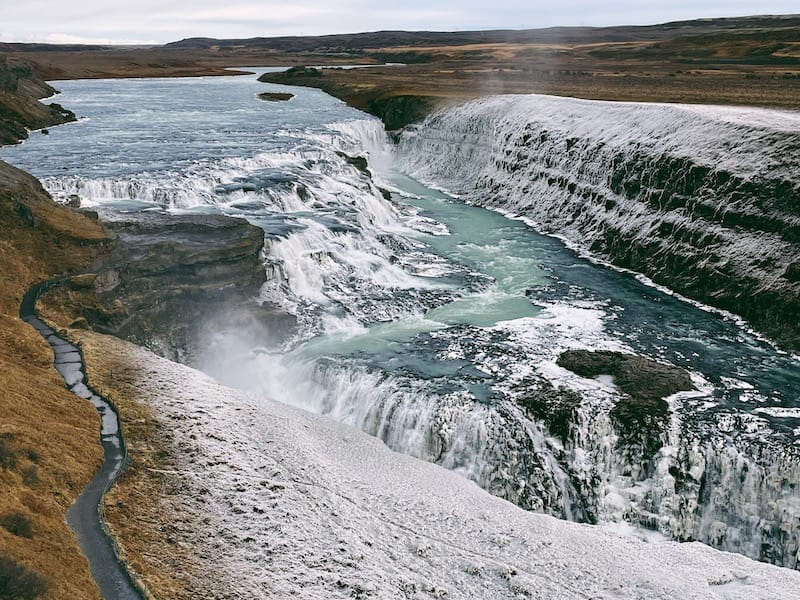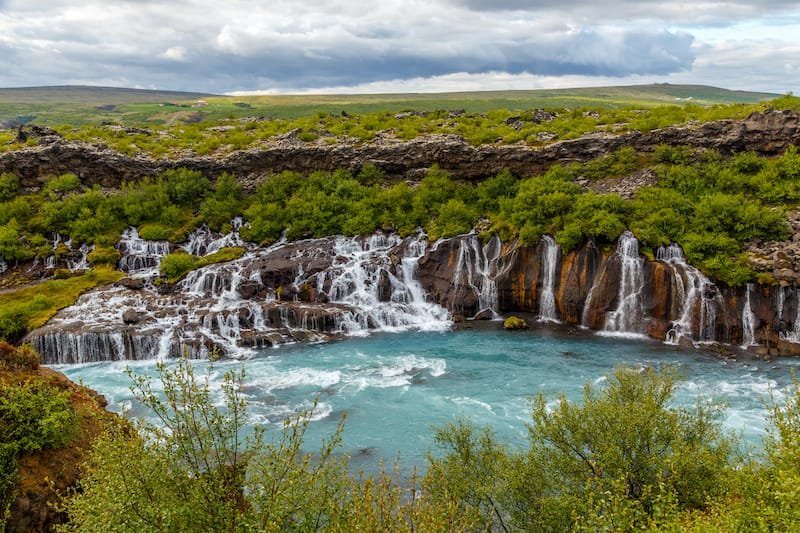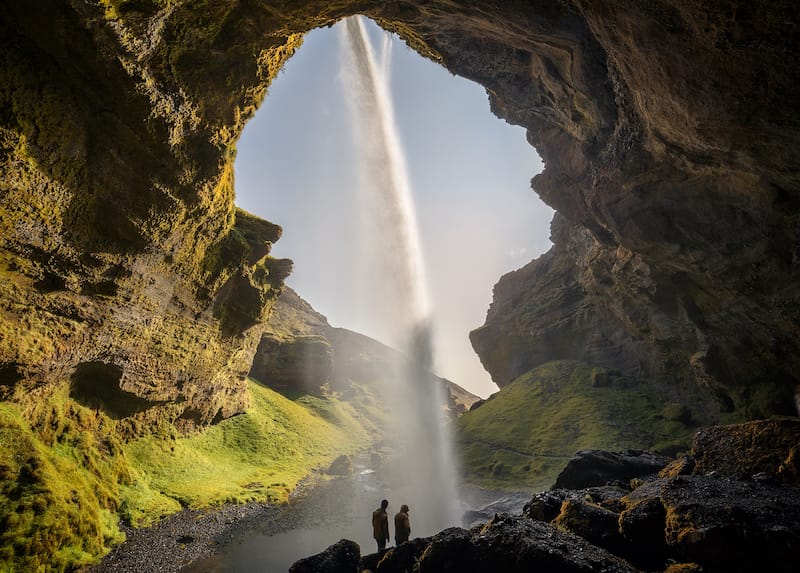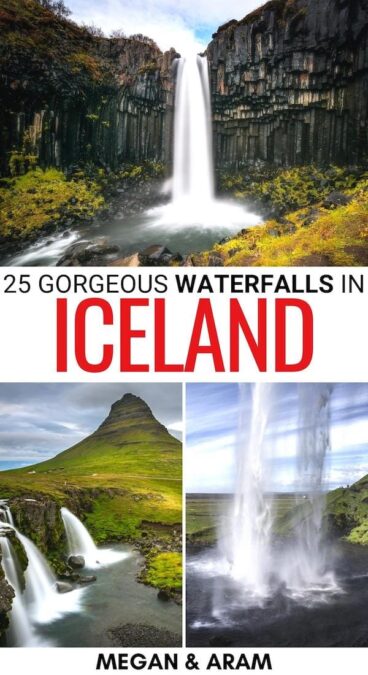Many waterfalls in Iceland make the trip worthwhile and a bucket-list adventure! These are the top Icelandic waterfalls that you can visit, including several popular ones and a few lesser-known ones!
If youʻre booking your trip to Iceland last minute, we have you covered. Below are some of the top tours, hotels, and more!
🇮🇸 Popular tours and activities in Iceland:
- Golden Circle day trip from Reykjavik (includes Kerid Crater)
- Jökulsárlón Glacier Lagoon Full-Day Trip (dinner in Vik)
- Blue Lagoon Admission with Transfers (for the bucket list)
🛌 Top places to stay in Iceland:
- Reykjavik Residence Apartment Hotel (Reykjavik)
- Centrum Hotel (Akureyri)
- Post-Plaza Guesthouse (Húsavík)
- Hotel Vík í Mýrdal (Vik)
✈️ Want to get from the airport to Reykjavik hassle-free? Find the best airport transfer option here!
🚗 Looking for the best way to get around Iceland? Click here to check rental car rates for Iceland!
Did I miss any amazing waterfall hikes in Iceland? Let me know in the comments. Thanks!
In this post...
Best Waterfalls in Iceland: The List
1. Gullfoss
Gullfoss is one of the most iconic and unique waterfalls in Iceland!
Located two hours from the capital of Reykjavik, in the canyon of the Hvítá River in southwest Iceland, it’s part of the Golden Circle sightseeing route and is not far from Geysir and other main Icelandic attractions.
Travelers can drive to the waterfall themselves or take a tour there, and the waterfall is best viewed from above (you really can’t go down to the bottom of it).

Gullfoss plunges into a gorge of water and forms two cascades; the shorter one is 36 feet (11 meters), and the second drop is 69 feet (21 meters).
The waterfall canyon walls reach up to 230 feet in height (70m) and then descend into Gullfossgjúfur Canyon.
In summer, about 459 cubic feet of water falls down the Icelandic waterfall every second, so be ready to get wet if the day is windy when you’re visiting Gullfoss Waterfall.
During the winter, be sure to wear grips on your shoes if you have a poor gait; it can be extremely icy!
2. Skógafoss
Skógafoss is an epic waterfall and one of the country’s biggest tourist attractions (with one of the largest drops). With a width of 82 feet (25 meters) and a drop of 197 feet (60 meters), it’s situated on the Skógá River, south of the Eyjafjallajökull glacier volcano.
The waterfall originates from the Eyjafjallajokull and Myrdalsjokull glaciers.
The land underneath the cascade is flat, and visitors can walk up to the vail of the water, making it extremely photogenic and a must-visit on any Iceland itinerary.

Due to the amount of cascade spray, at least one rainbow is seen on sunny days. You can also walk up a steep staircase, reaching the observation platform above the cascade, and enjoy the panoramic vistas of the waterfall and its surroundings from the top.
However, beware that if you visit in the winter, it can be a little icy on the way up! This is also the place where the popular hiking route, the Fimmvorduhals Pass, starts.
Skógafoss is included in many vacation packages and self-drive tours and is an easy stop on a South Iceland road trip (and it is not far from some of the best beaches in Iceland)!
3. Goðafoss
Located in the Skjálfandafljót River in northern Iceland, Goðafoss is one of the most spectacular waterfalls in Iceland.
Goðafoss means the waterfall of the gods, and it flows over a 98-foot-wide (30-meter) rock that rises in the center of the waterfall, separating it into two parts.
The first section is about 30 feet (9 meters), and the second is about 55 feet (about 17 meters) in height. It truly is marvelous and a must-visit if you’re in the north of Iceland!

Goðafoss is situated on the Ring Road, which encircles the country, and is also considered to be a part of the Diamond Circle sightseeing route.
The waterfall is included in almost all the day tours of North Iceland and is a highlight of many guided trips and self-drives. It is accessible year-round.
4. Gljúfrabúi
Rimmed in a narrow gorge, Gljúfrabúi waterfall is an undiscovered treasure on the South Coast!
This 131-foot-tall waterfall (40-meter-tall) is hidden behind a massive cliff, because of which most travelers overlook it and can’t easily stumble upon it.
The Gljúfurá Stream runs through a cleft in the cliff, and travelers must wade through it to approach Gljúfrabúi. The entrance to the cave isn’t easy, though!

The crack is narrow, but the sight inside is worth the effort. In addition, travelers can climb a narrow path up to the cliff in front of the waterfall and relish the stunning landscapes from above.
Gljúfrabúi is located in one of the most visited places in Iceland along the Ring Road, but make a conscious effort to check it out if you find yourself chasing waterfalls in Iceland! It’s easy to access it either alone or on a guided tour.
5. Kirkjufellsfoss
One of the most photographed waterfalls in Iceland is Kirkjufellsfoss. It’s located in the western part of the country, on the north side of the Snæfellsnes Peninsula.
With the famous mountain of Kirkjufell lurking in the background, this is one of the top tourist destinations in Iceland! To reach the falls, walk towards the mountain, cross the river, walk down a bit and enjoy the view.

The river Kirkjufellsá cascades from the volcano Helgrindur and has three waterfalls along it. All of them are called Kirkjufellsfoss, which means Church Mountain Falls in translation.
The steps of the waterfall aren’t very high, reaching about 16 feet (4.8 meters) in total. The dramatic view of Kirkjufellsfoss alongside the mountain is a photographer’s dream, so don’t expect to be alone there!
6. Dettifoss (and Selfoss)
The most powerful waterfalls in Iceland are situated 31 miles (50 kilometers) from Lake Myvatn, in the northeastern part of Iceland. The waterfalls have a 330-foot width (100 meters) and a drop from a 144-foot height (44 meters) down to the canyon of Jökulsárgljúfur.
Dettifoss is known as the second most powerful waterfall in Europe (the first is Rhine Falls).
This epic waterfall can be reached from two sides, both of which are easy to find with the pointing signs along the roads.

The western side is the easiest, from where you can view Dettifoss straight on. Follow the paths toward the south to find Selfoss. It’ll take you 20–30 minutes to reach Selfoss from Dettiffoss.
Both of the falls have belonged to the protected area since 1996.
There are no fences or platforms, and you can walk up really close to the water. Be aware of slippery rocks! Hiking shoes are recommended.
7. Aldeyjarfoss
Nestled among basalt columns, Aldeyjarfoss welcomes visitors with its breathtaking scenery. Located on the Skjálfandafljót River, it has a drop of about 66 feet (20 meters) into an icy pool below.
It’s not easy to find Aldeyjarfoss hidden in the north Icelandic highlands, but it’s a must-see for travelers who love mind-blowing nature.

The falls originate from Vatnajökull, the largest glacier in Europe, and driving there may be challenging. Check the roads and weather conditions and be sure to get there when it’s still light outside or it may present an issue.
Driving from Akureyri to Aldeyjarfoss takes about 1 hour in total. Follow the Ring Road (Route 1) toward the east, and turn right onto route 842.
Go on this route for a bit and take a turn to road F26, which will take you directly to the waterfall.
8. Háifoss
The country’s third tallest waterfall, known also as the most spectacular one by many, is located in the Fossárdalur Valley in South Iceland. It stands 400 feet tall (121 meters) in height and is fed by the Fossá River.
There’s another waterfall right beside Háifoss with less height and power called Granni where you can also see the powerful volcano of Hekla in the distance.

Reaching the falls requires a four-wheel-drive vehicle, and the best time to do so is in summer.
The road will take you to a parking lot south of the waterfall, from where you must have a short hike to reach the perfect viewing spot. Travelers can also hike to Háifoss by following the Fossá River from the historic farm Þjóðveldisbærinn Stöng.
9. Dynjandi
In the remote Westfjords of Iceland, travelers will find some of the biggest and most magnificent cascades in the region. Dynjandi covers a series of waterfalls and is a beloved spot for nature enthusiasts, photographers, and travelers.
The falls cascade about 328 feet (100 meters) over terraces of basalt boulders. It’s 98 feet wide (30 meters) at the top and 196 feet wide (60 meters) at the bottom.

Trekkers can take a hike 656 feet (200 meters) up the cliffside, passing seven individual falls; they’ll reach the largest one and will be able to enjoy the view from above.
The surrounding area of the waterfall is perfect for hiking, camping, and photographing in summer. One of the best options to visit Dynjandi is to have a self-drive journey, or you can join a guided tour.
10. Hjalparfoss
Another beautiful waterfall is found in Þjórsárdalur Valley, north of Hekla, the most active volcano in Iceland. The two-tiered falls cascade down into a huge plunge pool surrounded by basalt rock formations.
It looks like a bear’s head, which is another reason for its fame! It’s easily accessible and is seamless to visit at any time of the year, making it one of the coolest Iceland waterfalls to visit in both winter and summer.

Hjalparfoss boasts not only mind-blowing views but also is a place where travelers can simply go and take a dip in the waters. It takes about 1 hour and 40 minutes to reach the waterfall.
There are options for self-driving and guided tours. To access the place, drive Ring Road take Road 30 northward, and turn east to Road 32.
11. Svartifoss
If you take a short walk in Skaftafell National Park in the south of Iceland, you’ll find breathtaking views of Svartifoss. The waterfall is fed by the famous Svinafellsjokull Glacier.
It pours down 80 feet (24 meters) over a cliff, surrounded by tall black basalt columns and it doesn’t look like any other waterfall in Iceland!
These hexagonal columns were formed inside a lava flow and inspired the design of Iceland’s National Theatre and the Hallgrimskirkja church.

The base of the fall is known for its sharp rocks. To reach Svartifoss, take a hike from the Visitor Center where you will find maps and all kinds of information.
The trail is about 1 mile long (1.6 kilometers) and encompasses three other waterfalls. There’s a small bridge adjacent to the falls, which allows travelers to get up close and personal.
12. Faxafoss
Faxafoss, also known as Vatnsleysufoss, is located in the river Tungufljót in South Iceland. This impressive waterfall is nestled in a peaceful landscape plunging over 23 feet (7 meters) down.
But the highlight of the falls is its width of almost 263 feet (80 meters)! It’s possible to walk quite close to Faxi and feel the water drizzle.
Another interesting feature of the site is a man-made fish ladder on the side of the fall that helps salmon travel upstream.

Faxi is a part of the Golden Circle, and it’s easy to reach it. Take Road 35 to Reykholt from Selfoss. After 4.3 miles (7 kilometers), there’s a small road to the right leading to Vatnsleysufoss.
The surrounding area is mainly farmland. You’ll also find benches and tables to take a break or have a picnic and it is a great, peaceful stop on a South Iceland road trip.
13. Seljalandsfoss
Seljalandsfoss is a majestic Icelandic waterfall listed as one of the most visited and famous ones in the country. Located on the Seljalandsá River, it’s fed by the glacier Eyjafjallajökull.
The distinguishing feature of the falls is an encircling pathway, making it possible to see the falls from behind… but please note that this may have been removed.

The cascade is relatively narrow, with 196 feet in height (60 meters), and falls from the cliff that once marked the coastline. To see this mesmerizing waterfall, the visitors should be prepared to get dampened.
Seljalandsfoss is available both in summer and winter, but the path behind may not be accessible because of icy conditions in winter. It’s located right by Route 1.
If you walk along the left side of the waterfall up the path in winter, it is super icy! Be warned!
14. Brúarfoss
Known as Iceland’s bluest waterfall, it is not one that you should miss! Brúarfoss is situated between the renowned hot spring Geysir and the village Laugarvatn.
By the Brúará River, visitors will find a small parking lot. The falls are only about 16 feet high (5 meters), but it’s still unique.

The river Brúará ends in a U-turn at the base of the waterfall, where water plunges into a deep crack that stretches through dark volcanic formations and creates sky-blue rapids.
Your hike will start from the parking lot and will take up to one or two hours, including stops. The trail is easy and you will be gifted with picturesque views of rapids. The walking path is on private property, please note.
15. Gjáin
Gjáin is a spectacular ravine in Þjórsárdalur in South Iceland. It is a field packed with all kinds of geological formations that lava can create and is proven to be a powerful force field (and is a real treat to see with your own eyes)!
The valley is best known for its breathtaking waterfalls, the most famous of which is named Gjárfoss or just Gjáin. The waterfall Gjáin cascades down into the deep gorge of the valley.

There’s also another smaller fall dropping down in the valley, just beside Gjáin. Travelers can take a hike from the Saga Age farm of Stöng to reach the place.
It will take 15 minutes and will lead you to the northwest part of the valley. Another option is a moderate trail that will take you to the parking lot on the southern side of the valley.
16. Öxarárfoss
Öxarárfoss is one of the famous waterfalls in Iceland. Located in Þingvellir National Park, it flows out of the river Öxará and cascades over the cliffs of the Almannagjá Gorge.
The waterfall is 44 feet in height (13 meters) and 20 feet in width (6 meters). Its base is full of big smooth rocks, which get very icy in winter (the path there can also get icy toward the top even though it is wooden).

Travelers can visit the famous waterfall year-round. Expect crowds in summer, however. In winter, the waterfall freezes entirely and becomes an ice-climbing destination. It’s quite easy to access the place.
Take Ring Road Nr. 1 when driving from Reykjavík and turn west on Þingvallavegur nr. 36. Reach the sign for Öxarárfoss near the park entrance and head to the parking lot there.
The waterfall is just a short walk up the path or you can park at the visitor center for a longer walk.
17. Þórufoss
Þórufoss (or Thorufoss) originates from the Laxá í Kjós River and is situated in the east part of Lake Thingvallavatn. This scenic waterfall cascades 62 feet (19 meters) over a round cliff, stretching to about 100 feet wide (30 meters).

Though it’s not as powerful as other waterfalls of the Golden Circle route, Þórufoss is still among the prime South Iceland attractions. It’s possible to reach the base of the falls and get very close to it, but the slopes are rather unstable.
It’s simple to get to the place from the parking lot as it is located right next to road Nr. 48. The waterfall is also known as a key shooting location for Game of Thrones scenes!
18. Hraunfossar
Hraunfossar is a must-see waterfall when traveling in West Iceland! These majestic falls are situated in the Hallmundarhraun lava field in Borgarfjörður Bay.
Imagine countless falls cascading down a lava cliff about 3000 feet wide (915 meters)! Its water comes from the Langjökull Glacier, the second-largest glacier in the country.

Not far from the parking lot, travelers will find a viewing platform from where amazing scenery of the falls, the flowing river, and the surrounding area opens.
There’s also a pedestrian bridge across the river. It’ll take about an hour and a half to drive from Reykjavík to Hraunfossar. Getting there is easy, as the way is well-marked.
19. Glymur
Glymur is Iceland’s second-tallest waterfall. Situated in the fjord of Hvalfjörður, the grand and magnificent waterfall is worth exploring.
Fed by the Botnsá River, it stands at a height of 650 feet (198 meters). From Reykjavík, it takes forty-five minutes to get to the parking lot of Glymur.

Drive north on Route 1, and then turn right on Route 47. You’ll reach the edge of the fjord offering stunning views of the coast and mountains.
The Iceland waterfall hike starts from the car park and lasts about three and a half hours in total. Your journey will pass through nature and sometimes may be challenging.
The route is marked by signs, making it easy to follow, on the other hand.
20. Hrafnabjargafoss
Hrafnabjargafoss is one of the most hidden waterfalls of Iceland located in the Skjálfandafljót River. Known as the Raven Rocks Waterfall, it flows over the ancient rugged lava field Badar Dalshraun.
Hrafnabjargafoss stands at around 16 feet tall (4.8 meters) and consists of many chutes (volcanic rock formations). It has two cascades with an island in between.

The northern and eastern sides feature flowing rapids and streams. In the western and southern parts, the water pours down thunderously into a bowl-shaped pool.
Reaching the waterfall requires 4×4 vehicles, and the roads may be (almost) impossible in winter. In summer, it’s possible to hike to the place by joining an almost 10-mile footpath (16 kilometers) from the nearby waterfall Aldeyjarfoss.
21. Kvernufoss
Nestled in a gorge on the South Coast, Kvernufoss is an incredibly beautiful waterfall with a height of 98 feet (30 meters).
This waterfall is mostly overlooked on the South Coast tours, and you won’t meet crowds of people there, which will make your experience special compared to several other places in Iceland!

The hiking trail starts from the Skógar Cultural Heritage Museum and leads to the Kvernugil Gorge by the Kverná River. You’ll cross a small hill and will see Kvernufoss in its full glory.
The hike is flat and takes about 20 minutes to get there. In summer, travelers can walk behind the water curtains of the waterfall. However, in winter, slippery ice and falling icicles make it impossible to walk behind the falls.
22. Barnafoss
This rapid waterfall is situated in West Iceland and is famous for its dark folklore history. According to folk tales, two boys from a nearby farm tried to cross a natural stone bridge above the waterfall.
They felt dizzy, fell into the water, and drowned. Their grief-stricken mother cursed the bridge, and anybody who crossed it drowned. Later the bridge was destroyed in an earthquake.

Barnafoss, with its jaw-dropping surrounding area, is a magical waterfall in Iceland to visit. It originates from the Langjökull Glacier and is located in the center of a lava field named Hallmundarhraun.
The waterfall flows down a narrow valley, from which travelers can watch it from the top. Barnafoss and nearby Hraunfossar form the perfect road trip from Reykjavík. The drive takes 90 minutes, and the path is well-marked.
23. Ófærufoss
One of the main attractions in the Icelandic highlands is the waterfall Ófærufoss situated in the fissure Eldgjá.
This is one of the largest and longest canyons in the country, with around a 2000-foot width (609 meters) and 660-foot height (200 meters), and was formed during an eruption.
The waterfall falls in two cascades from 131 feet (39 meters) and boasts picturesque scenery filled with volcanic rocks and green moss. The best time to visit the waterfall is from July to September.

For the trip, the travelers will need a 4×4 vehicle. From Ring Road Nr. 1, turn north on Road Nr. 208, and after a short drive, take road F203. After a 15-mile (24-kilometer) drive, you’ll get right to the mouth of Eldgjá. The highland roads are inaccessible in winter.
24. Sigöldugljúfur Canyon
Hidden in the Icelandic highlands, Sigöldugljúfur Canyon boasts many small waterfalls, lava landscapes, a blue river, and vibrant vegetation.
You may not find it in the top list of attractions due to its remote location and challenging accessibility. But, travelers will be rewarded with pristine, unspoiled nature vistas.

The mountain roads require 4×4 vehicles, and it’s better to travel with a guide or an expert driver. The canyon is accessible only in summer.
From the capital, drive Route 1 South, pass Selfoss to Route 30, and turn right onto Route 32.
It will take you to the track F26, follow it to F208, go on the gravel trail, and you’ll reach Sigöldugljúfur. Be ready for a short hike over uneven ground!
25. Hafragilsfoss
Hafragilsfoss forms a part of the glacier river Jokulsa a Fjollum, located in North Iceland. The falls, 89 feet high and about 300 feet wide (91 meters), are nestled among cliffs.
Travelers can reach the canyon from both the east and west sides of the canyon’s river. It’s better to make your journey from the east side, however.
The parking lot for the waterfall is a great spot to view the canyon Jökulsárgljúfur. This is how you can gain access to the waterfall.
From Ring Road Nr. 1 go over the bridge on the Jökulsá á Fjöllum River and turn left after you pass the bridge north on Road Nr. 864. The parking lot of Hafragilsfoss is about a 20-mile drive (32 kilometers).
What are your favorite waterfalls in Iceland? Let us know in the comments!
Breathtaking Waterfalls in Iceland (On a Map!)
More Iceland Travel Guides
- Best Iceland beaches
- How to book an Iceland ATV tour
- Reykjavik in winter
- Best Silfra snorkeling tours
- Skaftafell Glacier Hiking
- How to Visit the Katla Ice Caves
- Villages in Iceland
- Places to visit in Iceland
- Westfjords road trip
- Visiting Iceland during April
- Lava Show in Reykjavik
Pin this Iceland Waterfalls Guide

Megan is a travel blogger and writer with a background in digital marketing. Originally from Richmond, VA, she now splits her time between Frankfurt, Germany and Arctic Finland after also living in Norway, Armenia, and Kazakhstan. She has a passion for winter travel, as well as the Nordic countries, but you can also find her eating her way through Italy, perusing perfume stores in Paris, or taking road trips through the USA. Megan has written for or been featured by National Geographic, Forbes, Lonely Planet, the New York Times, and more. She co-authored Fodor’s Travel ‘Essential Norway’ and has visited 45 US states and 100+ countries.

